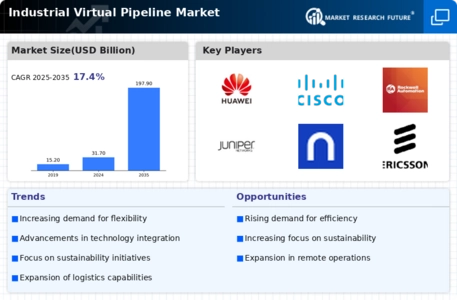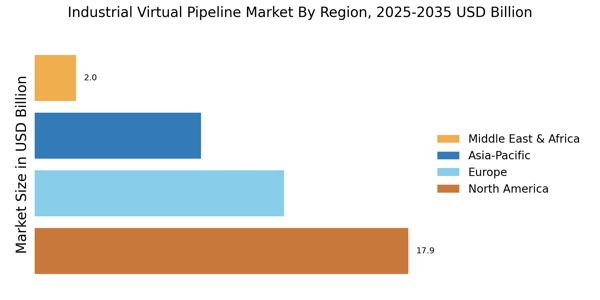Rising Demand for Energy Efficiency
The Industrial Virtual Pipeline Market is experiencing a notable increase in demand for energy-efficient solutions. Industries are increasingly seeking alternatives to traditional energy supply methods, which often involve significant costs and environmental impacts. The virtual pipeline system, which utilizes advanced technologies to transport energy resources, offers a more efficient and flexible approach. According to recent data, the energy efficiency market is projected to grow at a compound annual growth rate of approximately 8% over the next five years. This trend indicates a shift towards more sustainable practices, as companies aim to reduce their carbon footprints while maintaining operational efficiency. As a result, the Industrial Virtual Pipeline Market is likely to benefit from this growing emphasis on energy efficiency, positioning itself as a viable solution for various sectors.
Increased Investment in Infrastructure
Investment in infrastructure development is a critical driver for the Industrial Virtual Pipeline Market. As industries expand and modernize, the need for reliable and efficient energy transportation systems becomes paramount. Governments and private entities are allocating substantial funds to enhance energy infrastructure, which includes the implementation of virtual pipeline systems. Recent reports suggest that infrastructure investment in energy sectors is expected to reach trillions of dollars in the coming years. This influx of capital is likely to facilitate the adoption of innovative technologies within the Industrial Virtual Pipeline Market, enabling companies to optimize their energy supply chains and improve overall operational efficiency. Consequently, the growth of infrastructure investment is anticipated to create a favorable environment for the Industrial Virtual Pipeline Market.
Growing Adoption of Renewable Energy Sources
The shift towards renewable energy sources is significantly influencing the Industrial Virtual Pipeline Market. As countries strive to meet their renewable energy targets, the demand for efficient energy transportation solutions is increasing. Virtual pipelines provide a flexible means of transporting renewable energy, such as biogas and hydrogen, from production sites to end-users. Recent statistics indicate that the renewable energy sector is expected to grow by over 10% annually, driven by technological advancements and supportive policies. This growth presents an opportunity for the Industrial Virtual Pipeline Market to align with the renewable energy movement, offering solutions that facilitate the integration of clean energy into existing infrastructure. The increasing reliance on renewable energy sources is likely to propel the Industrial Virtual Pipeline Market forward, as industries seek sustainable alternatives to traditional energy supplies.
Technological Innovations in Energy Transport
Technological innovations are reshaping the Industrial Virtual Pipeline Market, providing new opportunities for efficiency and reliability in energy transport. Advances in digital technologies, such as IoT and AI, are enhancing the capabilities of virtual pipeline systems, allowing for real-time monitoring and optimization of energy flows. These innovations not only improve operational efficiency but also reduce the risks associated with energy transportation. The market for smart energy solutions is projected to grow significantly, with estimates suggesting a compound annual growth rate of around 12% over the next few years. This trend indicates a strong potential for the Industrial Virtual Pipeline Market to leverage these technological advancements, thereby enhancing its service offerings and attracting a broader customer base. As industries increasingly adopt smart technologies, the Industrial Virtual Pipeline Market is likely to experience substantial growth.
Regulatory Support for Alternative Energy Solutions
Regulatory frameworks are increasingly supporting the adoption of alternative energy solutions, which is a key driver for the Industrial Virtual Pipeline Market. Governments worldwide are implementing policies that encourage the use of cleaner energy sources and innovative transportation methods. This regulatory support is crucial for industries looking to transition from traditional energy systems to more sustainable options. Recent legislative measures indicate a trend towards stricter emissions standards and incentives for renewable energy adoption. As a result, the Industrial Virtual Pipeline Market stands to benefit from these favorable regulations, which may facilitate the integration of virtual pipeline systems into existing energy infrastructures. The alignment of regulatory policies with market needs is likely to enhance the growth prospects of the Industrial Virtual Pipeline Market, fostering a more sustainable energy landscape.


















Leave a Comment